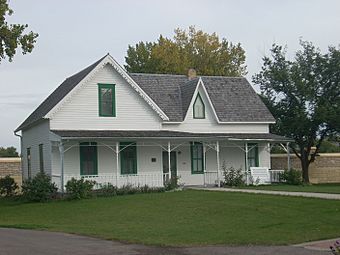Thomas D. Campbell House facts for kids
Quick facts for kids |
|
|
Thomas D. Campbell House
|
|
 |
|
| Location | 2405 Belmont Rd., Grand Forks, North Dakota |
|---|---|
| Area | less than one acre |
| Built | 1879 |
| Architectural style | Gothic Revival |
| NRHP reference No. | 87002010 |
| Added to NRHP | September 29, 1987 |
The Thomas D. Campbell House is a special historic home in Grand Forks, North Dakota. It's a mix of an old log cabin and a larger wood frame house. This house is important because it belonged to Thomas D. Campbell, who became the biggest wheat farmer in the entire United States! Today, it's part of the Myra Museum and is recognized as a historic place on the National Register of Historic Places.
Contents
What Makes the Thomas D. Campbell House Special?
The house was built in 1879 for Thomas D. Campbell. It started as a simple log cabin. Later, between 1881 and 1900, a bigger wood-frame part was added around the original cabin. This addition was built in a style called Gothic Revival. This means it has some fancy details like pointed windows and decorative trim.
The house has roofs with pointed ends, called gables. Its outside walls are covered with overlapping wooden boards, known as clapboard siding. You can see pretty, lacy wooden decorations, called bargeboards, on the main front and south gables. There's also a cool pointed window on the west side. A porch stretches across the front, supported by decorative posts and curved wooden arches. This house is the only building left from the Campbell family's original farm.
A Look Inside the House
Today, the inside of the Thomas D. Campbell House is a museum. It's set up to look like a family home from the early 1900s. You can still see the original log walls of the 1879 cabin from inside. The spaces between the logs, called chinks, are visible. You can also see the strong, hand-cut wooden beams that support the loft upstairs.
When the house was first built, it was outside the small town of Grand Forks. It was one of many pioneer homes along the Red River. There were no other buildings nearby at that time. Building log homes was common back then because it was expensive to bring cut wood down the river from Fargo. It was also common for people to build a simple log home first, then add a bigger house around it later. The Campbell House is special because it's one of the few Gothic Revival farmhouses in the whole Red River Valley area of North Dakota. When it was made bigger, it was one of the nicest homes around.
Who Was Thomas D. Campbell?
Thomas D. Campbell and his wife, Almira Richards Campbell, came from Scotland and Canada. They started their lives in the Red River Valley with a small farm. By 1898, their farm had grown to include about 4,000 acres (about 16 square kilometers) of excellent land for growing crops. As the 1900s began, Mr. Campbell became a very important person in real estate in the city.
The original log part of the house was the birthplace of their son, General Thomas D. Campbell (1882–1966). He became famous as the "Wheat King." He owned huge amounts of land in Montana and New Mexico. General Campbell was once the largest wheat producer in the United States. He also served in both World War I and World War II. During World War II, he helped develop important tools for the military.
See also
- Camp Four, historic wheat farming buildings on Campbell Farm



